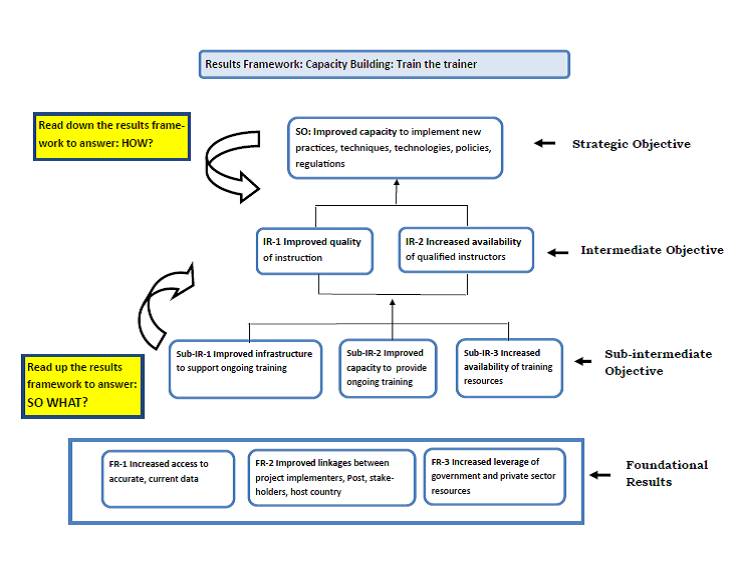As a visual person, I love using results frameworks to understand theory of change, identify indicators, and track progress. But, they are also a useful communication tool for project managers.
There are a lot of versions of results frameworks, but they all have similar basic characteristics; they are a graphical representation of a strategy and are generally laid out as a pyramid-like structure that cascades down from a goal, to a strategic or developmental objective, followed by intermediate objectives, and finally sub-intermediate objectives. In my work, I also use foundational results, which can feed into one or more higher-level results.
Using a results framework as a guide, it is much easier to explain “how” a project can achieve a strategic objective by following the results framework from top to bottom. It also answers the question, “So what?” by following the results framework from sub-intermediate objective up to strategic objective. The visual display of causal linkages between results is a useful tool for project managers to see where their projects fit into the bigger strategy, identify results related to activities, and identify results that were not included in the original proposal, but which are critical to success of the project.
Once a results framework is developed, indicators can be developed for each result. I like to have project managers identify activities that contribute to each result first, and based on the activities, tease out potential indicators that would best represent whether or not they are achieving that result. This way, project managers make a direct connection between the activities they are conducting and the results they are trying to achieve. It is much easier to answer the question, “What would it look like if I achieve this result?” when they are seeing activities tied to that result.
I work a lot with implementing partners, many of whom submit project proposals without results frameworks. As a project manager, I have found that it is much easier to identify strengths and gaps in a proposal when it includes a results framework. Such a framework helps the manager to ask critical questions of the implementing partners related to the theory of change and if a proposed activity mix is sufficient to achieve a result. Results frameworks also make it easier for project managers and implementing partners to discuss the proposed timeline for progressing up the results framework to achieve the project’s strategic objective. We use the results framework as the focus of the discussion, which keeps everyone on the same page, literally and metaphorically.
Here is an example of a simple results framework for train the trainer capacity building. Don’t be surprised if your results framework for capacity building looks somewhat different than this one. Results frameworks are a graphical representation of a strategy, so if your strategy is different, your results framework would likely be different.



 Sue Cottrell is a
Sue Cottrell is a 
